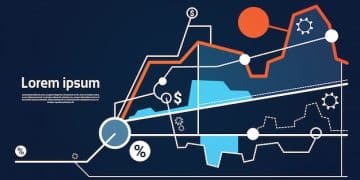Cybersecurity Investments: Protecting Your Business from Evolving Threats in 2025

Cybersecurity investments are no longer optional expenditures but critical strategic necessities for businesses aiming to survive and thrive amidst the rapidly escalating and evolving threat landscape, extending beyond mere compliance to proactive resilience in 2025.
In an increasingly digital world, the question isn’t if your business will face a cyber threat, but when and how effectively you can respond, making Cybersecurity Investments: Protecting Your Business from Evolving Threats in 2025 an unavoidable and strategic imperative for sustained operational integrity and market trust.
The Shifting Cybersecurity Landscape: Why 2025 is Different
The year 2025 marks a critical juncture in cybersecurity, characterized by an accelerated evolution of threats that demand more sophisticated and adaptive defenses. Businesses are now operating in an environment where traditional perimeter-based security measures are increasingly insufficient against highly sophisticated and persistent adversaries.
The sheer volume and complexity of data being generated, stored, and processed by businesses have created an expansive attack surface. This is compounded by the widespread adoption of cloud computing, remote work models, and the Internet of Things (IoT), each introducing new vulnerabilities and challenges that require continuous adaptation and significant strategic investment.
Emerging Threat Vectors
Cybersecurity threats are no longer simple phishing attempts or isolated malware attacks. They have evolved into intricate campaigns leveraging artificial intelligence, machine learning, and even quantum computing in their nascent stages to bypass conventional security protocols. The financial and reputational stakes are higher than ever, pushing businesses to reconsider their entire security posture.
- AI-Powered Attacks: Adversaries are using AI to craft more convincing phishing emails, automate reconnaissance, and develop polymorphic malware that evades detection.
- Supply Chain Vulnerabilities: Attacks increasingly target weaker links in the supply chain, compromising trusted third-party vendors to gain access to larger organizations.
- Ransomware 2.0: Beyond data encryption, modern ransomware often involves data exfiltration, forcing victims to pay not only for decryption but also to prevent sensitive information from being leaked.
- Deepfakes and Disinformation: Advanced synthetic media can be leveraged for social engineering, impersonating executives or key personnel to manipulate employees into granting access or transferring funds.
Understanding these shifts is foundational to formulating an effective cybersecurity strategy. It moves the conversation beyond mere compliance to genuine resilience and proactive defense. The cost of a breach far outweighs the preventative investments, encompassing not just financial penalties but also devastating blows to customer trust, brand reputation, and long-term business viability.
As we navigate towards 2025, the strategic imperative is clear: cybersecurity must be integrated into the core business strategy, not treated as an afterthought. This requires not only technological upgrades but also a cultural shift within organizations, emphasizing security awareness and accountability at all levels, from the executive suite to every individual employee.
Strategic Pillars of Cybersecurity Investment for 2025
Effective cybersecurity in 2025 demands a multi-faceted investment strategy that extends beyond mere technical solutions. It involves cultivating a stronger security culture, implementing advanced technologies, and fostering a resilient framework capable of continuous adaptation. These pillars are interdependent, forming a robust defense system.
A truly fortified organization understands that investment is ongoing, mirroring the dynamic nature of threats. This translates into a commitment to continuous improvement, research, and development within the company’s security ecosystem.

Advanced Threat Detection and Response
Investing in cutting-edge detection and response capabilities is paramount. This includes leveraging AI and machine learning to analyze vast amounts of data for anomalous behavior, identifying threats far more quickly than traditional methods. Endpoint Detection and Response (EDR) and Extended Detection and Response (XDR) solutions are becoming standard, offering comprehensive visibility across endpoints, networks, and cloud environments.
- Behavioral Analytics: Moves beyond signature-based detection to identify suspicious patterns of activity that may indicate a novel attack.
- Threat Intelligence Platforms: Integrates real-time global threat data to provide proactive insights into emerging attack methodologies and indicators of compromise.
- Security Orchestration, Automation, and Response (SOAR): Automates routine security tasks and facilitates rapid response to incidents, reducing human error and improving efficiency.
This focus on rapid detection and automated response minimizes the window of opportunity for attackers, significantly reducing the potential impact of a breach. It’s about moving from a reactive stance to a proactive one, where threats are identified and neutralized before they can cause significant damage.
Human Capital and Continuous Training
Technology alone is insufficient without a knowledgeable and vigilant workforce. Investment in human capital—recruiting, retaining, and continuously training cybersecurity professionals—is a critical pillar. The cybersecurity talent gap is widening, making internal development and strong security awareness programs essential for all employees.
Regular training sessions should cover evolving phishing techniques, social engineering tactics, and best practices for data handling. A strong security culture, where every employee understands their role in protecting the organization, transforms human vulnerability into a powerful defense layer.
The investment in people should also extend to internal red teaming and penetration testing, where ethical hackers simulate attacks to identify vulnerabilities before malicious actors can exploit them. This proactive approach strengthens a company’s defenses and ensures employees remain vigilant.
Ultimately, strategic investment in cybersecurity for 2025 is about building a resilient, adaptive, and human-centric defense. It aligns security initiatives with overarching business objectives, ensuring that protection is not merely a cost center but a core enabler of innovation and growth.
Evaluating ROI: Measuring the Impact of Cybersecurity Investments
Demonstrating the return on investment (ROI) for cybersecurity can be challenging, as its value often lies in what doesn’t happen—prevented breaches, maintained business continuity, and preserved reputation. However, quantifying this value is crucial for justifying continued and increased investment, especially in 2025.
Measuring ROI involves a blend of quantitative and qualitative metrics, moving beyond simple cost-avoidance to encompass business enablement and risk reduction. The goal is to articulate the strategic value of security in tangible business terms, making it clear that cybersecurity is an investment, not just an expense.
Quantifiable Metrics
While direct revenue generation from cybersecurity is rare, its financial impact can be quantified through avoided costs, operational efficiencies, and improved market positioning. Businesses can track metrics that illustrate the tangible benefits of their security programs.
- Reduced Breach Costs: Calculate the potential costs of a breach (forensic investigations, legal fees, regulatory fines, customer notification, credit monitoring, reputational damage) and compare them to actual breach costs or prevented incidents due to investment.
- Operational Efficiency: Measure the reduction in time spent on incident response, patching, or compliance activities due to automated tools and streamlined processes.
- Insurance Premium Reduction: Strong cybersecurity posture can lead to lower cyber insurance premiums, offering a direct financial saving.
- Customer Retention & Acquisition: Quantify the impact of demonstrated security on customer trust, potentially leading to higher retention rates and new business due to enhanced brand reputation.
These metrics, when tracked over time, provide a clear picture of the financial benefits accruing from cybersecurity investments. They allow organizations to present a compelling case for continued funding, showcasing how proactive security measures actively contribute to the bottom line by mitigating significant financial risks.
Qualitative Benefits and Risk Mitigation
Beyond direct financial metrics, cybersecurity investments yield significant qualitative benefits that are harder to quantify but essential for long-term business sustainability. These include enhanced brand reputation, competitive advantage, and improved regulatory compliance, all contributing to overall business resilience.
A robust cybersecurity posture can differentiate a company in the marketplace, reassuring customers and partners that their data and operations are safe. This trust is invaluable, especially in industries where data privacy and security are paramount. It can also provide a competitive edge, attracting clients who prioritize security.
Moreover, effective cybersecurity investments significantly reduce systemic risks, ensuring business continuity during disruptive events. This resilience translates into confidence for stakeholders, investors, and employees. The ability to withstand sophisticated attacks protects not just assets but also the very fabric of the organization’s existence.
Ultimately, evaluating ROI for cybersecurity is about demonstrating how these investments safeguard the organization’s future, enabling innovation and growth by providing a secure foundation. It shifts the discussion from cost to strategic value, highlighting cybersecurity as a critical enabler of modern business operations.
Regulatory Compliance and Data Governance in 2025
As businesses extend their digital footprint globally, complying with a patchwork of data privacy and cybersecurity regulations becomes increasingly complex. In 2025, the regulatory landscape is expected to be even more stringent, with new laws emerging and existing ones being more rigorously enforced.
Investment in robust data governance frameworks and compliance technologies is no longer a choice but a mandatory requirement to avoid hefty fines, legal battles, and significant reputational damage. This involves understanding and adhering to regulations like GDPR, CCPA, and emerging industry-specific mandates.
Navigating the Complex Regulatory Environment
The proliferation of data protection laws across different jurisdictions presents a significant challenge. Organizations must develop comprehensive strategies to identify, classify, and protect sensitive data in accordance with varying legal requirements. This requires continuous monitoring of legal developments and adapting internal policies accordingly.
Key considerations for compliance in 2025 will include:
- Cross-Border Data Transfers: Addressing the complexities of transferring data across different geographical regions, given divergent legal frameworks.
- AI and Data Usage: New regulations are anticipated regarding the ethical use of AI, particularly concerning data collection, processing, and bias.
- Sector-Specific Mandates: Industries like healthcare (HIPAA), finance (SOX, PCI DSS), and critical infrastructure are likely to face more prescriptive security requirements.
Effective navigation of this environment demands not only technical solutions for data security but also robust legal and compliance teams. Investing in external legal counsel specialized in cyber law and data privacy can be crucial for interpreting regulations and ensuring compliance strategies are sound.
Furthermore, automation tools designed for compliance management can help track regulatory changes, automate compliance checks, and generate audit trails, significantly reducing the manual burden and potential for human error. These tools become indispensable as the volume and complexity of regulations grow.
The Role of Data Governance
Beyond mere compliance, establishing strong data governance practices is fundamental to managing vast datasets responsibly and securely. Data governance defines who can take what actions, with what data, under what circumstances, using what methods, and with what results.
It ensures data quality, integrity, and security throughout its lifecycle, from creation to disposal. Strong data governance acts as a foundational layer that supports compliance efforts by ensuring data is systematically managed, accessible only to authorized personnel, and protected against unauthorized access or breaches.
Investment in data governance platforms provides centralized visibility and control over an organization’s data assets. This enables more efficient data classification, risk assessment, and policy enforcement. By viewing data governance as a strategic asset, businesses can not only meet regulatory obligations but also unlock new opportunities for data-driven insights while maintaining trust.
Ultimately, a robust approach to regulatory compliance and data governance in 2025 is about building trust with customers and stakeholders while mitigating legal and financial risks. It transforms compliance from a burden into a strategic enabler for secure and responsible business operations.
Future-Proofing Your Defenses: AI, ML, and Quantum
The relentless pace of technological advancement means cybersecurity defenses must continually evolve to stay ahead of increasingly sophisticated threats. In 2025 and beyond, artificial intelligence (AI), machine learning (ML), and the nascent field of quantum computing will play pivotal roles in shaping the future of digital security.
Investing in these cutting-edge technologies is crucial for businesses aiming to future-proof their operations against emerging threats that leverage similar advanced capabilities. This proactive approach ensures resilience against attacks that might bypass current, more conventional security measures.

AI and ML in Cybersecurity
AI and machine learning are rapidly transforming cybersecurity by enhancing analytical capabilities and enabling automated responses. These technologies can process and analyze vast quantities of data far more quickly and accurately than humans, identifying subtle patterns and anomalies that indicate potential threats.
- Predictive Analytics: AI-powered systems can predict potential attack vectors and vulnerabilities by analyzing historical data and threat intelligence, allowing for proactive defensive measures.
- Automated Threat Response: ML algorithms can automate incident response, isolating infected systems or blocking malicious traffic in real-time, significantly reducing the impact of a breach.
- Enhanced Anomaly Detection: Beyond traditional signature-based detection, AI/ML models learn normal network behavior and flag deviations, making them highly effective against zero-day exploits and polymorphic malware.
Investing in AI and ML-driven security solutions means moving towards a more intelligent, adaptive defense system. These technologies reduce the burden on human security teams, allowing them to focus on more complex strategic tasks rather than routine alerts. They enable organizations to detect and neutralize threats with unprecedented speed and precision, offering a significant advantage in a rapidly evolving threat landscape.
Preparing for Quantum Threats (Post-Quantum Cryptography)
While still in its early stages, the advent of quantum computing poses a long-term threat to current cryptographic standards. Quantum computers have the potential to break many of the encryption algorithms used today, jeopardizing vast amounts of sensitive data.
Though mainstream quantum computing strong enough to break current encryption is still some years away, businesses must begin to consider the implications and invest in research and development for post-quantum cryptography (PQC). This involves understanding the principles of quantum-resistant algorithms and planning for future migrations.
Key actions for businesses include:
- Crypto-Agility: Developing systems that can easily swap out cryptographic algorithms as new, quantum-resistant ones become standardized.
- Quantum-Safe Research: Supporting and monitoring the development of PQC standards and solutions from leading research institutions and vendors.
- Inventory of Cryptographic Assets: Identifying all systems, applications, and data relying on current cryptographic methods to understand the scope of future migration.
Addressing quantum threats now, even in their nascent form, is an exercise in long-term strategic planning. It ensures that when quantum computing becomes a widespread reality, organizations will be prepared to transition to new security paradigms without significant disruption. Future-proofing defenses against quantum threats is a testament to an organization’s commitment to enduring security, reflecting foresight and strategic prudence rather than reactive urgency.
In essence, investing in AI, ML, and preparing for quantum challenges is about staying one step ahead. It’s about building a security infrastructure that is not only robust for today’s threats but also agile and adaptable enough to face the unknown challenges of tomorrow.
Building a Culture of Cybersecurity and Resilience
Beyond technology and compliance, the most robust defense in 2025 is a strong organizational culture of cybersecurity. This isn’t merely about employee training sessions; it’s about embedding security awareness and responsibility into the very fabric of the company, from top leadership to new hires.
Cultivating such a culture transforms employees from potential vulnerabilities into the frontline of defense. It fosters a proactive mindset where security is viewed not as a hindrance but as an integral part of everyone’s job, essential for protecting the business and its stakeholders.
Leadership Commitment and “Security by Design”
A true culture of cybersecurity starts at the top. When leadership actively champions security initiatives, allocates necessary resources, and sets clear expectations, it sends a powerful message throughout the organization. This commitment needs to be visible, consistent, and integrated into strategic planning processes.
Furthermore, adopting a “security by design” philosophy ensures that security is considered at every stage of product development, system implementation, and process design. Rather than bolting security on as an afterthought, it is baked into the architecture, dramatically reducing vulnerabilities from the outset.
- Executive Buy-In: Regular communication from leadership on the importance of security, coupled with tangible support for security training and initiatives.
- Cross-Functional Collaboration: Breaking down silos between IT, development, legal, and business units to ensure security is a shared responsibility.
- Dedicated Security Budget: Allocating sufficient and consistent funding specifically for ongoing security enhancements, training, and tools, signaling its strategic importance.
When security is a core business value, it influences decision-making, promotes secure practices, and ultimately creates a more resilient organization. This top-down commitment also helps in attracting and retaining top cybersecurity talent, as professionals seek environments where their expertise is valued and supported.
Empowering Employees and Continuous Learning
Empowering employees with the knowledge and tools to be effective defenders is paramount. This involves more than just annual training; it requires continuous education, interactive simulations, and accessible resources that make security awareness engaging and relevant.
Effective training programs include:
- Regular Phishing Simulations: Testing employees’ ability to identify and report deceptive emails, providing immediate feedback and additional training.
- Interactive Workshops: Hands-on sessions covering secure coding practices, data handling, and incident reporting procedures.
- Gamification and Rewards: Incentivizing secure behavior and knowledge retention through friendly competitions or recognition programs.
Creating a safe environment where employees feel comfortable reporting suspicious activities without fear of reprimand is also critical. This encourages vigilance and turns every employee into an active participant in the organization’s defense strategy.
A culture of cybersecurity fosters resilience, enabling organizations not only to prevent breaches but also to recover quickly and effectively when incidents inevitably occur. It’s about collective responsibility, continuous learning, and adapting to an ever-changing threat landscape with a united front.
Budgeting for Breakthroughs: Optimizing Cybersecurity Spending
In 2025, merely increasing cybersecurity spending is insufficient; businesses must strategically optimize their budgets to achieve maximum impact. This involves prioritizing investments based on risk assessment, leveraging automation, and adopting flexible solutions that can adapt to evolving threats without massive overhauls.
Optimized budgeting ensures that resources are allocated to areas that yield the highest return in terms of risk reduction and business continuity. It shifts from reactive spending to proactive, data-driven investment decisions, recognizing that security is a continuous, evolving process.
Risk-Based Prioritization
The first step in optimizing cybersecurity spending is conducting a thorough risk assessment to identify the most critical assets, potential vulnerabilities, and the likelihood and impact of various threats. Not all risks carry the same weight, and resources should be directed towards mitigating the highest-priority concerns.
This approach allows businesses to:
- Focus on High-Impact Areas: Direct funds to protect core business functions, sensitive data, and critical infrastructure that, if compromised, would cause the most significant financial or reputational damage.
- Avoid Overspending on Low Risks: Prevent unnecessary expenditure on pervasive but low-impact threats, freeing up resources for more pressing needs.
- Align Security with Business Objectives: Ensure that cybersecurity investments directly support the organization’s strategic goals and risk tolerance.
Regularly updating risk assessments is crucial, as the threat landscape, business operations, and regulatory requirements all evolve. This dynamic view ensures that budgeting remains agile and responsive to changing priorities, avoiding stagnant or misdirected investments.
Leveraging Automation and Cloud-Native Security
Automation is central to optimizing cybersecurity spending by increasing efficiency and reducing reliance on manual processes, which are prone to human error and labor-intensive. Investing in Security Orchestration, Automation, and Response (SOAR) platforms can streamline incident response, patch management, and compliance checks.
Furthermore, embracing cloud-native security solutions offers significant cost efficiencies and scalability. Cloud providers often invest heavily in security infrastructure, and their services can be more flexible and cost-effective than managing on-premise solutions. Cloud-native security, including Security Information and Event Management (SIEM) and micro-segmentation, provides robust protection without the overhead of physical hardware.
Key benefits of automation and cloud-native security include:
- Reduced Operational Costs: Automation minimizes the need for extensive human intervention in routine tasks, freeing up security analysts for more complex challenges.
- Scalability and Flexibility: Cloud solutions scale easily with business growth and can adapt quickly to new security requirements without significant capital expenditure.
- Improved Incident Response: Automated workflows enable faster detection and remediation of threats, minimizing dwell time and potential damage.
Optimizing cybersecurity spending in 2025 is not about cutting corners but about investing smarter. By prioritizing based on risk, leveraging the power of automation, and adopting agile cloud-native solutions, businesses can build resilient defenses that provide superior protection and a clear return on investment, aligning security imperatives with fiscal responsibility.
| Key Area | Brief Description |
|---|---|
| 🛡️ Evolving Threats | Cyber threats in 2025 are AI-driven, highly sophisticated, and target supply chains, requiring proactive adaptive defenses. |
| 💰 ROI & Value | Measuring ROI involves avoided breach costs, operational efficiency, and enhanced brand reputation, crucial for justifying spend. |
| ⚖️ Compliance Focus | Stricter global regulations and data governance are mandatory to avoid fines and maintain trust. |
| 🧠 Future Technology | AI, ML, and preparing for quantum cryptography are vital for future-proofing defenses. |
Frequently Asked Questions About Cybersecurity Investments
▼
Cybersecurity investments are crucial in 2025 because the threat landscape is rapidly evolving with AI-driven attacks, increased supply chain vulnerabilities, and sophisticated ransomware. Proactive investment protects against significant financial losses, reputational damage, and operational disruption, ensuring business continuity and compliance with stringent regulations.
▼
Measuring ROI involves quantifying avoided costs from prevented breaches (e.g., legal fees, regulatory fines), assessing operational efficiencies gained through automation, and observing reductions in cyber insurance premiums. Qualitative benefits like enhanced brand reputation and competitive advantage through increased customer trust also contribute significantly to the overall return.
▼
AI and Machine Learning are pivotal for future cybersecurity strategies by enabling predictive analytics, automating threat detection and response, and enhancing anomaly detection against novel attacks. These technologies allow security systems to identify sophisticated threats faster and more accurately, significantly improving an organization’s defensive capabilities and reducing response times.
▼
Employee training is extremely important as human error remains a leading cause of security breaches. Comprehensive training programs, including phishing simulations and ongoing education, empower employees to recognize and report threats. This fosters a strong security culture where every individual acts as a crucial line of defense, significantly bolstering overall organizational resilience.
▼
Regulatory compliance heavily influences cybersecurity investments by necessitating adherence to strict data privacy laws (e.g., GDPR, CCPA) and industry-specific mandates. Non-compliance can lead to substantial fines and reputational harm. Therefore, investments in robust data governance and compliance automation tools become essential to navigate the complex legal landscape and minimize risk.
Conclusion
The landscape of cybersecurity in 2025 presents a complex yet critical challenge for businesses worldwide. No longer merely an IT concern, Cybersecurity Investments: Protecting Your Business from Evolving Threats in 2025 has cemented its place as a fundamental pillar of business strategy, directly impacting financial stability, operational continuity, and market reputation. The proliferation of AI-driven threats, the intricate web of supply chain vulnerabilities, and the increasingly stringent regulatory environment demand a proactive, multi-faceted approach. Success hinges not just on acquiring advanced technologies, but on fostering a robust security culture from the top down, empowering every employee, and continually adapting to an ever-evolving threat landscape. By strategically optimizing budgets, prioritizing risks, and embracing cutting-edge solutions, businesses can transform cybersecurity from a defensive necessity into a strategic enabler for growth and innovation, safeguarding their future in an increasingly digital world.





